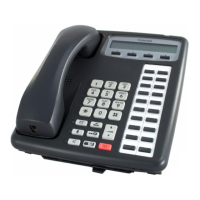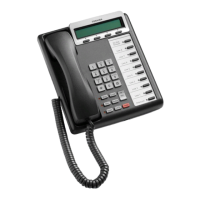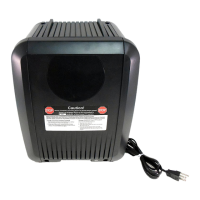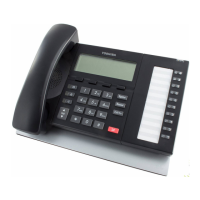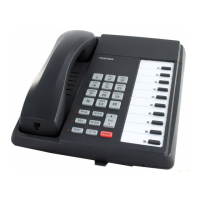Features
Cancel Button
Strata CTX General Description 11/02 45
Off-hook Camp On
A station caller who dials a busy station or line access code can remain off-hook to be
automatically connected when the station or line becomes idle. After dialing a busy [DN] and
receiving busy tone, the caller can just remain off-hook and Camp On will be initiated
automatically after a predetermined time or the user can dial a
and remain off-hook to initiate
Camp On immediately. When camp-on is activated, the caller will receive success tone followed
by Ring Back Tone. The station that is the object of a camped-on call will receive two bursts of
call waiting tone (see Call Waiting).
Even if Voice First is set at the called [DN], the station will be called by tone ringing when it is
connected by Camp On. Internal and external stations can be the object of a Camp On. Calls may
be camped on to the pilot number of Station Hunting groups and will be delivered to the first
station in the group to become idle. ACD pilot numbers cannot be the object of a Camp On.
Incoming calls from outside lines to busy DNs camp-on automatically (see “Automatic Camp
On,” previous section). When a station dials the access code for an outside line and receives busy
tone because all lines are busy, the user can remain off-hook and dial
to camp on to the busy line
group. When a line becomes available, the station will connect to the line and receive dial tone.
When more than one party is camped on (queued) to a destination, the party with the highest
Queuing Priority Level (QPL) will be connected first when the destination becomes available. If
the parties have the same QPL, the longest waiting call will be connected first.
Calls will camp on to hunt groups when all members of the group are busy (see “Station Hunting”
on page 64 for more details).
Cancel Button
The &DQFHO button voids the last entry or step in a procedure. This enables the station user to
correct an error and then continue without having to starting over.
It is important to consider the consequences of this button in regards to the overall task. For
example, during a conference call,
&DQFHO will disconnect the last party added to the conference.
Centrex/PBX Compatible
All system features are compatible with Centrex/PBX operation, including repeat of Centrex/PBX
ringing cadence, one-button access to Centrex/PBX features, a two- to five-digit station numbering
plan, and Delayed Ringing to selected stations.
Centrex Ringing Repeat
The system can mimic CO/Centrex/PBX ringing cadences received from outside lines when it
rings a called station.
Classes of Service (COS)
Classes of Service are the mechanisms for assigning features and services to lines and stations
within the system. The Class of Service for a given device, such as a station, is defined using 38
parameters. There are 32 Class of Service patterns available, each pattern can be set up to allow a
unique combination of features. Each station and line group can be assigned independently to one
of the 32 COS patterns.

